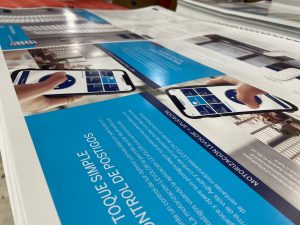Are you working on a brochure, pamphlet or other print piece but have no clue about the right paper selection? If you’re trying to decide between coated and uncoated paper, things can get a bit tricky if you don’t know what each kind of paper offers.
Knowing the particular traits of coated and uncoated paper is a crucial starting point for your project, here’s what you should know.
Coated Paper
Coated paper is produced during manufacturing with an extra layer, which causes the paper to be less porous. It has clay or polymer coating applied to either one or both sides of the paper, making it reflective. When used in printing, coated paper presents sharper and brighter images or designs because it absorbs less ink. Coated paper is resistant to dirt, moisture, and wear and tear, and this helps to keep your printed piece appearing crisp and professional for a longer period than uncoated paper. Note that it’s more difficult to use a pen or pencil to write on coated paper. Because coated paper absorbs less ink, it’s ideal for finishing techniques such as flood or spot varnish.
Related: 6 Unique Paper Types Your Marketing Craves!
There are different types of coated paper:
- Gloss-Coated Paper
- High shine and is great for high-contrast projects. It also has a wider color range than other papers. It’s the ideal paper for marketing materials and magazines that use a lot of color images or designs. The gloss coating of this paper allows color images to “pop” because of its greater depth of color saturation. Please note, however, that it’s prone to glare, which can make it harder to read text.
- Dull-Coated Paper
- Less sheen than gloss-coated paper, and less glare. The surface is smooth, which supports high-quality base image reproduction. This combination makes dull-coated paper great for print designs where both images and text are important for readability.
- Matte-Coated Paper
- Similarities to dull-coated paper, being less shiny than gloss-coated paper. Matte-coated paper is lighter than other coated stock, but is suited for elevating the appearance of visual design in prints, such as journals and calendars.
- Cast-Coated / High-Gloss Paper
- Heavily coated, super-shiny paper, and is of superior quality. If glare is something you want to avoid with your print piece, consider opting for a matte-coated paper rather than cast-coated, as cast-coated paper is highly reflective. Furthermore, cast-coated paper is prone to cracks because of the heavy coating, and is not suited for print pieces that require folding. Compared to other coated stock, cast is much more challenging to work with and is more costly.
Related: Planning Pagination for Brochures, Booklets and Magazines
Uncoated Paper
Uncoated paper absorbs ink because the surface is made to be more porous and no clay coating was added during manufacturing. The surface has a more natural and rough texture because wood fibers are more exposed, and thus it doesn’t have as smooth a surface as coated paper. The textured feel adds character to the paper, and it looks more “traditional” than modern, coated paper. Color may appear darker on uncoated paper than on coated, and images are less sharp. More ink is absorbed by uncoated paper, which may cause images to appear fuzzy, and the edges of images may appear less defined.
Related: Texture Impacts Perception
Consider some of these benefits offered by uncoated paper:
- Uncoated paper’s absorbency makes it a great option for writing with pencil or pen.
- Lacking the shiny finish of coated paper, the uncoated surface and greater definition makes it easier to read large amounts of printed text.
- Engravings involving embossed shapes or foil stamped designs are easier to accomplish when working with uncoated paper.
- Uncoated paper works well for printing to communicate elegance and refinement, or a classy appearance.
- Uncoated paper is not only an economically appealing option, but it’s an aesthetically pleasing one as well.
Think of uncoated paper as the everyday paper meant for general office and home usage. Uncoated paper is great for real estate brochures, restaurant menus, forms and worksheets, business stationery (calling cards, invoices, letterhead and envelopes, etc.), and booklets that need a classic or elegant touch.
Related: How Much Do Brochures Cost
Deciding between coated vs. uncoated paper may boil down to your print objective. Each offers different benefits and is better suited for particular print jobs. Knowing the traits of each paper can help you to make the best selection for your print job. Ironmark’s print experts can also weigh in if you need them – just get in touch today, and we’ll make sure you get the right material for your next print project.




